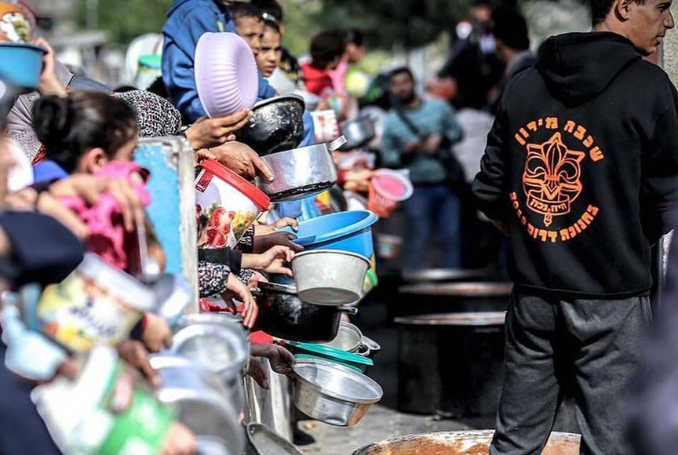
Israeli human rights group, B’Tselem has warned that the entire Gaza population is going hungry, saying about 2.2 million people “are surviving day by day on almost nothing.”
In a statement on Monday, the non-governmental organization said, “The desperate search for food is relentless, and usually unsuccessful, leaving the entire population – including babies, children, pregnant or nursing women and the elderly – hungry.”
The Gaza Strip, B’Tselem explained, was already in the throes of a humanitarian crisis before the war, mainly due to Israel’s 17-year blockade.
About 80 percent of the population relied on humanitarian aid, with some 44 percent of households food insecure and another 16 percent at risk of food insecurity.
“Given this starting point, it is clear why Gaza plummeted into a full-blown catastrophe so quickly,” the rights group said.
Famine Review Committee
It cited the report on the situation in Gaza published by the Integrated Food Security Phase Classification (IPC) Famine Review Committee (FRC), dated December 21, 2023. The FRC, which consists of independent experts, uses the internationally accepted classification of food insecurity levels, the most severe being Phase 5 – Catastrophe/Famine. According to this method, urgent intervention is needed as of Phase 3 (Crisis or worse) in order to protect the population.
Based on information collected in the Gaza Strip from 24 November 2023 to 7 December 2023, the FRC found that during this time, in four of five households in northern Gaza and in half of Internally Displaced Persons (IDP) households in the south, residents went days without any food and many skipped meals to feed their children, the B’Tselem statement said.
About 93 percent of the population in Gaza – some 2.08 million people – were suffering from acute food insecurity at Phase 3 or higher, with over 15 percent – 378,000 people – already at Phase 5.
One in Four Will Reach Phase 5
The report also forecasts that by 7 February 2024, the entire population of the Gaza Strip will reach Phase 3 or worse. At least one in four residents – more than 500,000 people – is expected to be at Phase 5, facing extreme food shortages, hunger and exhaustion.
According to the report, if current conditions persist, there is a significant risk that famine will be declared throughout the entire Gaza Strip within six months.
The report explained that such a declaration is made when 20 percent of households reach Phase 5, when 30 percent of children suffer from severe malnutrition, and when two adults or four children out of 10,000 die of hunger every day.
‘A Direct Result of Israel’s Policy’
B’Tselem also cited a UNICEF survey from December 26, 2023, that found an increasing number of children are not receiving their basic nutritional needs. About 90 percent of children under age two in Gaza consume food from two or fewer food groups. The nutrition of pregnant and nursing women has also been severely compromised, with 25 percent consuming only one type of food, and almost 65 percent only two types.
“This reality is not a byproduct of the war, but a direct result of Israel’s declared policy,” said B’Tselem, adding that residents now depend entirely on food supplies from outside Gaza, as they can no longer produce almost any food themselves.
“Most cultivated fields have been destroyed, and accessing open areas during the war is dangerous in any case,” it said.
Bakeries, factories and food warehouses have been bombed or shut down due to lack of basic supplies, fuel and electricity, while stockpiles in private homes, stores and warehouses have long since run out.
“In these conditions, the family and social support networks that helped residents at the beginning of the war collapsed, too,” it said.
‘Starvation as Method of Warfare is a War Crime’
Yet Israel is deliberately denying the entry of enough food into Gaza to meet the population’s needs, the statement stressed.
“Only a fraction of the amount of food entering before the war is allowed in, with limitations on the types of goods, how they are brought in and how they are distributed within Gaza.”
The rights group was adamant that, “Israel can, if it so chooses, change this reality.”
Gaza Faces Widespread Hunger as Food Systems Collapse – World Food Program
The images of children begging for food, people waiting in long lines for paltry handouts and hungry residents charging at aid trucks are already inconceivable, it said.
“The horror is growing by the minute, and the danger of famine is real. Still, Israel persists in its policy,” the group added.
It said changing this policy “is not just a moral obligation…starvation as a method of warfare is prohibited.” Adding that “when a civilian population lacks what it needs to survive, parties to the conflict have a positive obligation to allow rapid and unimpeded passage of humanitarian aid – including food.”
“These two rules are considered customary law and violating them constitutes a war crime under the Rome Statute of the International Criminal Court,” the rights group concluded.
Based in Jerusalem, B’Tselem is The Israeli Information Center for Human Rights in the Occupied Territories.
(The Palestine Chronicle)









I think the comparison in international law are Concentration Camps – the British ones during the Boer War, the American ones in the Phillipines during the “pacification” of the Phillipines after the Spanish-American War, and the pre-Death Camp Concentration Camps of the Third Reich, before they started the Gas Chambers, when they hoped to starve the inmates into early deaths, allowing preventable diseases to kill the off en masse. Also the POW Camps of the Soviet POWs, where they starved POWs to an early death.